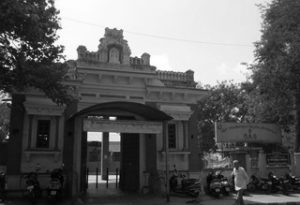Among the Sanskrit Vidwans whose patronage I sought, it was Sri Motaganahalli Sankara Sastri who showered me with love and affection. There was no other Vidwan with whom I enjoyed the kind of liberty that I enjoyed with him. From the beginning he regarded me as one of his own and displayed great warmth. I had developed immense respect towards him much before I even went to him in person. The reasons were twofold:
- M Srinivasa Rao and K.A. Krishnaswami Iyer had jointly translated and published Maharshi Vidyaranya’s Pancadashi in English. In that translation, they have expressed their gratitude to the great assistance provided by Vidwan Sankara Sastri. When I brought this topic up with Krishnaswami Iyer, he said that Sri Sankara Sastri’s outlook was modern, and how he could sympathetically grasp the trend of thought of the present world. I thus developed curiosity in the matter of Sri Sankara Sastri.
- It was the time when the Sri Rameshwara Temple in Chamarajapet had just been consecrated. Every evening, Diparadhana (offering of lights) was performed there. As part of this offering, the temple Archaka would say, “cūrṇikāmavadhāraya” and “stotrapāṭamavadhāraya.” [This is typically an invocation to any devotee to sing stotrams or hymns in praise of the Deity]. At this point, two people would begin to sing slokas. That was when I first heard the sloka, “sānaMdaM naMdihastāt.” I was thrilled the moment I heard it. I thought, “is there anybody who can sing slokas in this manner?” The eminent duo were brothers named Sankara Sastri and Ramasesha Sastri.
This was yet another reason for my deep reverence towards Sri Sankara Sastri.
Discourse and Commentary
The brothers would recite the Puranas in the same manner in which they recited slokas. On occasion, a recital of the Bhagavata Purana took place in the Rameshwara Temple. Ramasesha Sastri would recite it; Sankara Sastri would provide the commentary. One day, it was the episode of Sri Krishna coming down to the earth as an Avatar. ekāyano ’sau dvi-phalas tri-mūlaś catū-rasaḥ pañca-vidhaḥ ṣaḍ-ātmā | sapta-tvag aṣṭa-viṭapo navākṣo daśa-cchadī dvi-khago hy ādi-vṛkṣaḥ || tvam eka evāsya sataḥ prasūtis tvaṁ sannidhānaṁ tvam anugrahaś ca | tvan-māyayā saṁvṛta-cetasas tvāṁ paśyanti nānā na vipaścito ye || I distinctly remember Ramasesha Sastri singing this poem in a Ragam which he embellished with great creativity. But what made a greater impact on my mind was the oratorical style of Sankara Sastri’s commentary. Sri Sankara Sastri split each word and quoted correspondent examples from the Upanishads and expounded philosophy through a combination of Sastra and his own contemplations. In the foregoing poem, he explained two methods of splitting the phrase respectively as, “paśyanti nānā na + vipaścitah” and “paśyanti nānā + navipaścitah” and the nuances of each of the two meanings. That style, the style of expounding the meanings, the sheer decisiveness of inspiration that stemmed from the sincerity in his heart—I was amazed at all of this.
In those days, a sizeable number of Vidwans would be present at gatherings like this. Kadur Venkatasubbayya, “Amruta Mahal” Timmappayya, “Choubeene” Subbbaraya, Anegondahalli Subbanna—these were among the prominent Vidwans attending such gatherings with great enthusiasm each evening. Such luminaries as Chappalli Visweshwara Sastri, Hariyappacharya and others would also be present. Maharshi Valmiki in his Srimad Ramayana in his description of the Ayodhya city has praised its citizens as “samAjotsavashAlinah,” [those who were enthusiastic in participating in the festival called society] not once, not twice, not thrice but numerous times. This “festival called society” was visible to the eye in the period I’m referring to.
Satsang
Sri Sankara Sastri worked as a Sanskrit Teacher in the Rao Bahadur Arcot Narayanaswami Mudaliar High School located in the Bangalore Cantonment. During the same period, a person named Sitarama Sastri was working as a Kannada Pandit in the same school. My Respected relative Mottanahalli Venkappayya was the English Teacher there. Because I was largely unemployed back then, each afternoon at about four-thirty, I would go the aforementioned school from Chamarajapet and meet these three elders and return to the city with them. During the course of our walk back, our conversation would be filled with joy and laughter. The expansive row of trees in Cubbon Park behind the Museum was soothing. We would sit underneath them for a while and assuage our fatigue by engaging in poetry recitals and singing. I have said elsewhere that Sri Venkappayya was a music exponent. For this reason, there was a good bond between him and Sankara Sastri. Sri Venkappayya would take up some Ragam at random. Accordingly, Sankara Sastri would take up a random poem. Both would sing it together. Its meaning and explanation would follow. Sri Sitarama Sastri would join in this. An argument would erupt. It would heat up. Venkappayya would provide some examples from the English lore. Suddenly all of us would realize that it was late in the evening. Then we would all get up and depart towards our homes. Such episodes didn’t occur merely on one day or a month; it went on for two or three years. None of the three are alive now.
Writing Literature
Sri Sankara Sastri possessed the felicity to compose both verse and prose. In spite of this, he hasn’t authored any book. It didn’t appear to me that he had a proclivity to write, even. In general, our Vidwans of that era weren’t trapped in the fancy of writing books. As far as I know, Sri Chappalli Visweshwara Sastri hasn’t written a single verse. If young boys and men wrote something and showed it to him, he would read it, feel happy, and leave it at that. The towering Vidwan renowned as an outstanding Pandit, “Mahamahopadhyaya,” “Vidyanidhi,” Hanagal Virupaksha Sastri did not embark on writing any book. These folks typically didn’t have such inclinations. They were simply content with mastering the Sastras and disseminating them accurately. They felt that their life’s work was complete just by doing this much. Sri Sankara Sastri did compose stray poems on occasion. This was in the nature of “shAkAya vA syAt lavaNAya vA syAt” [a proverb which literally means, “enough for vegetables and salt”]. He had authored some plays for the owners of bookstores bearing such titles as “Sananda Ganesha,” “Indrasabha,” “Pandava Vijaya,” and so on. He himself regard these as great works. On occasion, when I made lighthearted fun of these plays, he said, “The fire in the kitchen must keep burning, my boy! If you so wish, I’ll write a couple more. What do I lose?” At most, he would earn five or ten rupees from this kind of writing.
Poetic Style
Sri Sankara Sastri had an excellent style in Sanskrit poetry. Both Shabdalankaram (embellishment, ornamentation, decoration in terms of word usage) and Arthalankaram (embellishment, ornamentation, decoration in terms of meaning) were obedient to him. He had composed a few poems on the occasion of the marriage of the Prince of Mysore [Princely State]. I recall one. parisḥadayam dhārmikajana - gōtrōdhārānurāgī saksḥtrā || na samā~nayā sudharmā sa puṇyajanagōtrabhit sa naksḥatrā || This is an example of Shabdalankaram. The fruit of this came in the form of shawls and other goodies. When the Sringeri Jagadguru visited Bangalore, Sri Sankara Sastri offered a garland of twenty-four poems at his Divine Feet. The style of these poems was highly erudite. When he recited them aloud in that gathering of learned people, I was standing next to him. After he finished reading a particular verse, someone in the audience—perhaps it was Srikanta Sastri—said in Telugu, “Please read it again.” The Jagadguru himself said, “It’s really good!” Sri Sankara Sastri read the verse again. Everyone greatly appreciated it. One verse has remained in my memory. tīrtḥēna tīrtḥashōSḥah kyāpi na druSḥṭō na shrutōpi mayā || lōkagurudatta tīrtḥāt bhavābditīrtḥaM vilīyatē citraM || I also recall a few words from yet another poem. cinmūrtirāsāditapuṇyakīrtih yā sḥāMtamūrtistapasāM prapūrtih || This was the sort of his mastery over Shabdalankaram. Sri Sankara Sastri was fond of lighthearted humour. He would lightly tease his neighbor, Channarayapattana Venkataramanayya and another person named Krishnacharya. Both were Sanskrit Vidwans. But because they were short-tempered, they would get inflamed quickly. Then Sri Sankara Sastri would smile and pacify them. Venkataramanayya had composed a few panegyric poems in Kannada on some public occasion. One line in the poem was as follows: mudadiM mādhava maMtri cūtavanadoḶ putṭaṆṆa satkōkilaM || Sri Sankara Sastri read this aloud and teased Venkataramanayya. His expression became thorny at this. Then Sri Sastri pacified him and made him laugh. He had nicknamed Krishnacharya as “Bhallookaacharya” [Bear Acharya]. All of this was purely in jest. Sri Sankara Sastri harboured no ill-will or enmity against anyone. Nor did he have any enemies. Those who came in contact with him displayed gentleness, humility, and devotion towards him. When Sri Sankara Sastri passed away in 1912-13, he hadn’t attained old age. According to my recollection, his eldest son, Subrahmanya Sastri was a boy of six or seven at that time. This is the English translation of the fourteenth chapter of D V Gundappa’s Jnapakachitrashaale – Vol. 5 titled “Vaidikadharma Sampradayastharu.” Translated by Sandeep Balakrishna.















































